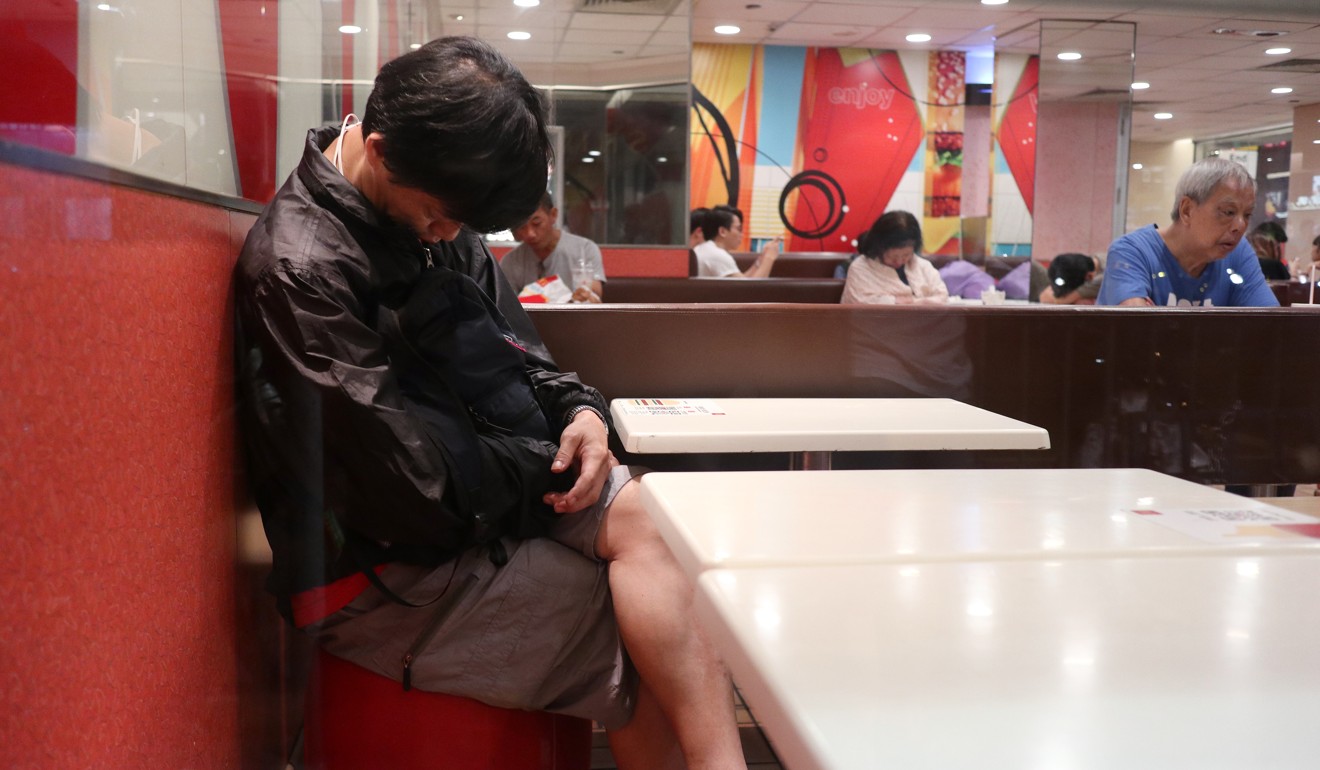
Number of people sleeping in Hong Kong McDonald’s branches skyrockets, as residents battle high rents and substandard housing
Study finds that, surprisingly, many who chose to spend their nights in branches of the fast-food chain have homes of their own
The number of people sleeping in McDonald’s outlets has increased six-fold over the past five years, a trend partly driven by rising rents and substandard housing that makes life especially unbearable in the city’s baking weather, a study has found.
The survey, organised by Junior Chamber International’s Tai Ping Shan branch and conducted in June by volunteers, found 334 people had slept in a McDonald’s outlet nightly over at least the past three months. Of the 110 branches that operate 24 hours in the city, 84 had seen overnight sleepers.
This is a six-fold increase from a similar study in 2013, which found only 57 such people, popularly dubbed McRefugees or McSleepers.
A branch in Tsuen Wan hosted more than 30 sleepers, the highest among all branches, according to the latest study.
Researchers were able to interview 53 McRefugees aged between 19 and 79 in depth, and found 57 per cent of them had a job and 71 per cent of them had flats that they rented or owned, contrary to the common belief that these people tended to be jobless and homeless.
Saving on air conditioning costs, as well as comfort and security, topped a list of reasons given by these interviewees, followed by high rents, conflict with family members, the ability to develop social relations at the chain and substandard housing.
Hong Kong’s McSleeper trend rises 50 per cent in three years, as NGO highlights vulnerability of women in the group
Other reasons included saving on transport costs and time to work, and seeking temporary shelter while waiting for low-rent public housing.
“Family is the basic unit in a society,” Tai Ping Shan publication commission chairwoman Jennifer Hung Sin-yu said. “Even one person who has a home but cannot return is too many. This phenomenon is worth our attention.”
Hung said the reasons given by interviewees showed that unaffordable housing had forced the poor into inferior living conditions such as subdivided flats, which subsequently drove them into McDonald’s for comfort and security.
One McRefugee renting a subdivided flat in To Kwa Wan, Hung said, told volunteers that her landlord charged her HK$16 for a unit of electricity, compared to about HK$1.10 charged by the city’s two main power suppliers.
Hung said the woman’s flat did not have any windows, which made the city’s humid and hot summer even more unbearable without air conditioning.
“She told us sometimes she couldn’t even feel the flow of the air,” Hung said.
Hong Kong is consistently ranked the world’s least affordable property market. As of the end of March, there were 270,000 applicants on the waiting list for public rental housing; the average waiting time for families or single elderly applicants was five years and one month.
The lonely life of the McSleepers, the poor who call McDonald’s home
Subdivided housing is the main option for these families while they wait, but it is affordable only because of the small sizes – often around 100 sq ft – of these units, which entail fire risks, poor ventilation and poor hygiene.
Besides inadequate housing, family problems are another main issue, Hung said.
One of the cases, a 19-year-old referred to in the study as Ah Lung, was a construction worker who ate, played mobile phone games and slept at a McDonald’s branch in Mong Kok. He did not want to go home due to a bad relationship with his parents, while his income enabled him to live away from home.

A 60-year-old woman was observed by volunteers as “without the unique characteristics of street sleepers”. She was well dressed, with her diamond wedding ring still on her finger. She also had a flat in the New Territories, but had nobody to share the home with her.
She and her late husband did not have any children and she felt lonely in her home and eating by herself, which was why she spent most of her time at the fast-food chain, where there were many people coming and going.
Project consultant Lee Ho-ey said the government should allocate more resources to non-governmental organisations to reach out to McRefugees, providing them with counselling and help.
He said the government should allocate more resources to non-governmental organisations to reach out to McRefugees frequently and regularly, providing them with counselling and help.
He added that officials should regularly conduct surveys on this group of people to stay updated.
The Social Welfare Department has not responded to a request for comment.

